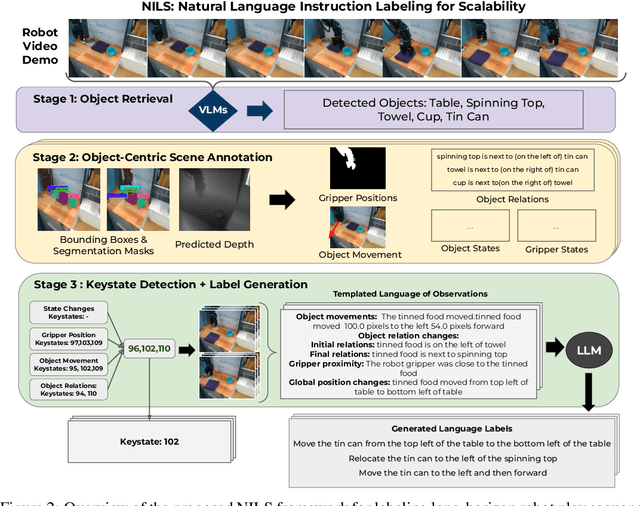Ömer Erdinç Yağmurlu
Scaling Robot Policy Learning via Zero-Shot Labeling with Foundation Models
Oct 23, 2024



Abstract:A central challenge towards developing robots that can relate human language to their perception and actions is the scarcity of natural language annotations in diverse robot datasets. Moreover, robot policies that follow natural language instructions are typically trained on either templated language or expensive human-labeled instructions, hindering their scalability. To this end, we introduce NILS: Natural language Instruction Labeling for Scalability. NILS automatically labels uncurated, long-horizon robot data at scale in a zero-shot manner without any human intervention. NILS combines pretrained vision-language foundation models in order to detect objects in a scene, detect object-centric changes, segment tasks from large datasets of unlabelled interaction data and ultimately label behavior datasets. Evaluations on BridgeV2, Fractal, and a kitchen play dataset show that NILS can autonomously annotate diverse robot demonstrations of unlabeled and unstructured datasets while alleviating several shortcomings of crowdsourced human annotations, such as low data quality and diversity. We use NILS to label over 115k trajectories obtained from over 430 hours of robot data. We open-source our auto-labeling code and generated annotations on our website: http://robottasklabeling.github.io.
Multimodal Diffusion Transformer: Learning Versatile Behavior from Multimodal Goals
Jul 08, 2024Abstract:This work introduces the Multimodal Diffusion Transformer (MDT), a novel diffusion policy framework, that excels at learning versatile behavior from multimodal goal specifications with few language annotations. MDT leverages a diffusion-based multimodal transformer backbone and two self-supervised auxiliary objectives to master long-horizon manipulation tasks based on multimodal goals. The vast majority of imitation learning methods only learn from individual goal modalities, e.g. either language or goal images. However, existing large-scale imitation learning datasets are only partially labeled with language annotations, which prohibits current methods from learning language conditioned behavior from these datasets. MDT addresses this challenge by introducing a latent goal-conditioned state representation that is simultaneously trained on multimodal goal instructions. This state representation aligns image and language based goal embeddings and encodes sufficient information to predict future states. The representation is trained via two self-supervised auxiliary objectives, enhancing the performance of the presented transformer backbone. MDT shows exceptional performance on 164 tasks provided by the challenging CALVIN and LIBERO benchmarks, including a LIBERO version that contains less than $2\%$ language annotations. Furthermore, MDT establishes a new record on the CALVIN manipulation challenge, demonstrating an absolute performance improvement of $15\%$ over prior state-of-the-art methods that require large-scale pretraining and contain $10\times$ more learnable parameters. MDT shows its ability to solve long-horizon manipulation from sparsely annotated data in both simulated and real-world environments. Demonstrations and Code are available at https://intuitive-robots.github.io/mdt_policy/.
 Add to Chrome
Add to Chrome Add to Firefox
Add to Firefox Add to Edge
Add to Edge